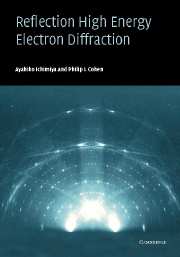Book contents
- Frontmatter
- Contents
- Preface
- 1 Introduction
- 2 Historical survey
- 3 Instrumentation
- 4 Wave properties of electrons
- 5 The diffraction conditions
- 6 Geometrical features of the pattern
- 7 Kikuchi and resonance patterns
- 8 Real diffraction patterns
- 9 Electron scattering by atoms
- 10 Kinematic electron diffraction
- 11 Fourier components of the crystal potential
- 12 Dynamical theory – transfer matrix method
- 13 Dynamical theory – embedded R-matrix method
- 14 Dynamical theory – integral method
- 15 Structural analysis of crystal surfaces
- 16 Inelastic scattering in a crystal
- 17 Weakly disordered surfaces
- 18 Strongly disordered surfaces
- 19 RHEED intensity oscillations
- Appendix A: Fourier representations
- Appendix B: Green's functions
- Appendix C: Kirchhoff's diffraction theory
- Appendix D: A simple eigenvalue problem
- Appendix E: Waller and Hartree equation
- Appendix F: Optimization of dynamical calculation
- Appendix G: Scattering factor
- References
- Index
3 - Instrumentation
Published online by Cambridge University Press: 06 July 2010
- Frontmatter
- Contents
- Preface
- 1 Introduction
- 2 Historical survey
- 3 Instrumentation
- 4 Wave properties of electrons
- 5 The diffraction conditions
- 6 Geometrical features of the pattern
- 7 Kikuchi and resonance patterns
- 8 Real diffraction patterns
- 9 Electron scattering by atoms
- 10 Kinematic electron diffraction
- 11 Fourier components of the crystal potential
- 12 Dynamical theory – transfer matrix method
- 13 Dynamical theory – embedded R-matrix method
- 14 Dynamical theory – integral method
- 15 Structural analysis of crystal surfaces
- 16 Inelastic scattering in a crystal
- 17 Weakly disordered surfaces
- 18 Strongly disordered surfaces
- 19 RHEED intensity oscillations
- Appendix A: Fourier representations
- Appendix B: Green's functions
- Appendix C: Kirchhoff's diffraction theory
- Appendix D: A simple eigenvalue problem
- Appendix E: Waller and Hartree equation
- Appendix F: Optimization of dynamical calculation
- Appendix G: Scattering factor
- References
- Index
Summary
Introduction
In RHEED, an electron beam, at an energy usually between 8 and 20 keV for epitaxial growth systems, is incident on a crystal surface at a grazing angle of a few degrees. At the surface there is a scattering process in which there can be energy loss. Diffracted beams leave the crystal, also near grazing incidence, and strike a detector. It is a very open geometry, with the incident beam and detector as much as 20 cm from the sample. It is exceedingly surface sensitive. As a result, RHEED is an ideal measurement to combine with atom deposition, Auger electron spectroscopy, scanning tunneling microscopy, scanning electron microscopy and other surface probes. The appropriate experimental methods depend on the measurements desired and on the sample. In this chapter we describe several designs.
The optimal energy for electron diffraction depends somewhat on the purpose of the measurement. Electron optics become easier as the energy is increased but there does not seem to be any overriding issue. For dynamical analysis, as will be seen later, a planewave expansion is performed since at high energies the scattering is mainly in the forward direction and this is efficient. A spherical-wave expansion could also be used, but this is inefficient since at high energies many diffracted beams will be needed. So for dynamical analysis, energies greater than about 10 keV are essential. However, at lower energies it is possible to go to higher incident glancing angles and still maintain surface sensitivity.
- Type
- Chapter
- Information
- Reflection High-Energy Electron Diffraction , pp. 12 - 18Publisher: Cambridge University PressPrint publication year: 2004

